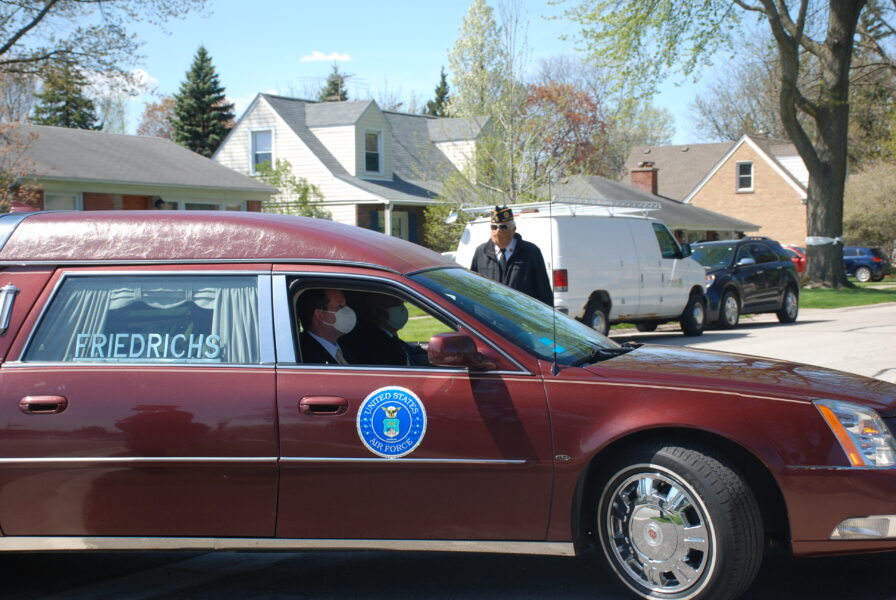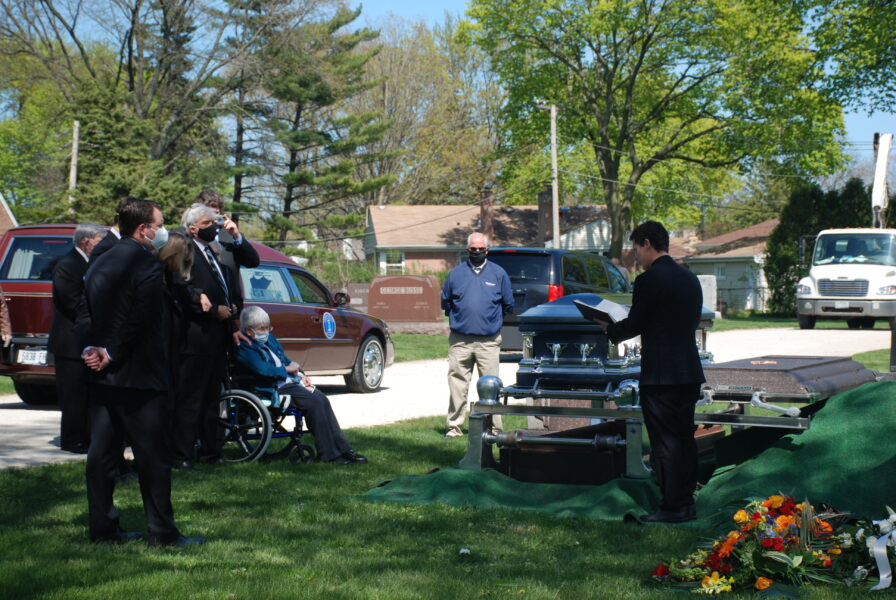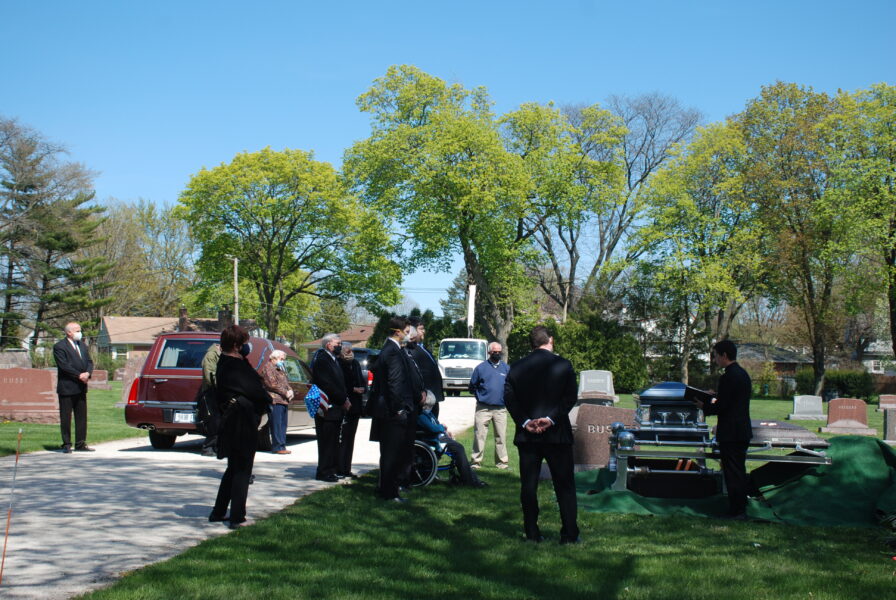Friedrichs Funeral Home has been a part of the Mount Prospect community since 1958 and during the COVID-19 pandemic of 2020-21, it was run by Hank Friedrichs Jr., grandson of the founder.

Unlike businesses that simply had to figure out how to continue to ply their trades during a tragic time with repeated lock-downs, funeral homes had to figure out how to do business while also physically dealing with people’s loved ones who had died of a myriad of diseases and causes, including the scary and new COVID-19 virus.
Over a 14-month span, Friedrichs handled arrangements for 35 COVID victims, as well as many more who died of other medical conditions, accidents, old age and so forth.
“Like every business, COVID affected us tremendously overnight,” Friedrichs recalled. “In the beginning, nobody knew how COVID was really transmitted and how long the virus could live in the air. We were picking up folks who had passed away from COVID – which was a concern. We were using safety precautions, but also, there were folks who had passed away from the COVID who had probably exposed family members to COVID and we were, in some cases, having contact with those family members. So, we were very concerned about exposure to COVID,” Friedrichs recalled.

And in the early days, he admitted that they – like everybody else – got caught flatfooted and only had about ten full PPE sets of equipment on hand. “And that was not going to be nearly enough to get us through the COVID time. Our suppliers – the people we buy our funeral industry supplies from – really came through on the PPE for us. They kept us supplied with PPE throughout the COVID times and we were very thankful for that.”
“One of the things we did here, because of that concern, was to cut our staff back. We continued to keep the part-time staff who do all the clerical and cleaning and that type of stuff on the payroll, but we told them to stay home. I’ve got two funeral directors and two hearse drivers and I made two teams of two and they would work every other day. I did that so that the chance of an entire staff coming down with COVID was limited because they were not around each other. I do have to say that the teams of two did the work of a team of about five people. My staff really came through for us.”
Another major change Friedrichs Funeral Home had to make involved technology. “When somebody passes away, the family comes into the funeral home and we make arrangements. That is how it has been done for years,” he explained. “But when COVID hit, families didn’t want to come into the funeral home and, quite honestly, we weren’t sure we wanted families coming into the funeral home. So, we had to learn how to make that initial arrangement session using technology and between Facetime and Zoom calls, we were able to do that.”
They also had to figure out how to let people choose caskets, vaults and printed materials from their homes. So, the technology of just the arrangement session was a big change, right from the beginning, he explained.

Figuring out how to livestream funerals so that people could watch from home was the next hurdle.
“We’re not IT people here but we had to start livestreaming – and reliably livestreaming – services. When I say reliably, you don’t want to tell a family that you have that technology (and they have 30 or 40 people sitting in their homes) and suddenly it’s not coming up and they can’t see the funeral service. So, there was a lot of pressure on us to get a reliable livestreaming service going.”
The types of funeral services offered also had to change – literally over night!
“A majority of the services that we have here at Friedrichs are what we call “traditional funerals”. This involves a one-night visitation (usually from 3 until 9) and then a funeral service or funeral Mass the next day and off to the cemetery. Immediately that stopped.”
During the pandemic they, of course, followed the CDC and state guidelines and limited services to ten people.
“So, a lot of folks – right at the beginning – were just meeting at a cemetery. Others that did want to have more of a traditional type of funeral, meaning a viewing, held a one-hour viewing in the morning, for ten people – and then it was off to the cemetery. And that is how, for the first several months of the COVID, we were doing funerals. You couldn’t have more than ten people, so people didn’t want to come here and sit for six hours in the afternoon, so they came for one hour in the morning,” Friedrichs explained.
“During this time, it was quite heartbreaking because we had to tell people that they could only have ten people in the funeral home for their loved one’s funeral,” he continued. “Oftentimes, that doesn’t cover the immediate family. We had one family with eight kids. They couldn’t even bring their spouses, much less the grandchildren or brothers and sisters, to the funeral. For us, that was hard.”
“No families ever fought us on that because we were all in this together, but when you want to offer compassion in a final sendoff for somebody’s loved one, you want to be able to do your best and by only allowing ten people, we felt like we weren’t doing that.”
Friedrichs said that as time went on, the state requirements changed, and they were able to increase the number of people in the funeral home to 50.
“This was nice. It still didn’t really open up and allow for a traditional funeral, but it did allow more people to come in. The advantage we have here at Friedrichs is we have two chapels and the wall between them can come down and it can become one very large chapel. So, throughout the entire COVID time, whether there were ten people or 50 people permitted, we were always able to have plenty of room for people to “social distance” in the funeral home.”
“Even today, toward the end of the COVID era, we still don’t see a lot of traditional funerals coming back,” he continued. “We have more, but we still see a lot of the one-hour (in the morning) wakes and services and I don’t know if ‘traditional funerals’ will ever again be a majority of the services we do. That is yet to be seen.”
“But making arrangements by computer has already gone away. People are more willing to come into the funeral home now.”
Livestreaming of funerals, on the other hand, is here to stay.
Looking back, Friedrichs said that limiting the number of people who could come to a funeral was hard for them to deal with. They were never really overrun with COVID deaths. The number of funerals they did during COVID was a little bit higher than the previous year or two, but those fluctuations happen in their industry.
Actually, Friedrichs said that the death rate during COVID kind of mirrored what they normally see in the fall and winter when the first flu virus goes through nursing homes. COVID was much more deadly and much more contagious, he admitted, but the death rate mirrored what they normally see during different times of the year and they were never really overrun with COVID deaths.
“I think that the one thing I will personally remember is that it was almost hopeless for everybody at the beginning of COVID. There was really no light at the end of the tunnel. It was a sad time. I’ve never lived through something like that,” he recalled.
“I lived through 9/11 and that was a horrible tragedy. But within days after 9/11, while things changed all over the world, things were starting to get back to normal here,” he continued. “With COVID, we went for over a year with things not being normal and just as human beings, we’re not built to be able to deal with that. It was very hard on me, personally. and I’m not saying anything that I’m sure anybody else out there who has lived through the last year and a couple months would say differently.”
In the late spring of 2021, he added, Friedrichs Funeral Home was notified by their national association that FEMA had come up with a plan to give up to a $9,000 reimbursement to families whose loved ones had died of COVID. So, the Friedrichs staff went back through their records and notified every family that had a loved one who died of COVID that they were eligible for that money and relayed what they needed to do to access it.